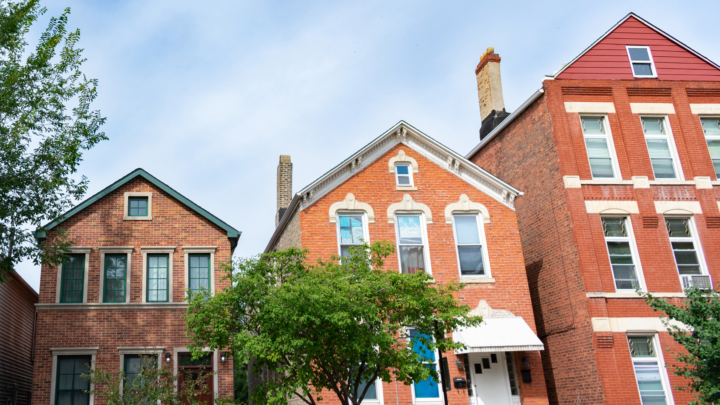How Does Refinancing Work: A Guide for Homeowners
There are many benefits to refinancing your mortgage - like lowering your monthly payment and potentially saving thousands in interest. Read on to see if refinancing is right for you.

You can refinance your mortgage for a variety of reasons. A lot of homeowners refinance because rates are constantly changing, home improvement projects are on the horizon and saving money is always a good feeling.
What is refinancing?
Refinancing is when you replace an existing loan with a new loan. Mortgage refinancing allows a homeowner to borrow funds at a more favorable interest rate, repay the funds over a different length of time or withdraw from or add to your home equity.
How does refinancing work?
Refinancing works by acquiring a new mortgage loan which is used to pay off and close the original loan. Your new monthly payments, length of loan and interest rate are all based on the terms of the new refinanced loan.
For example, if you refinance to a 30-year mortgage, it doesn't matter how many years you paid on your original loan — your payment cycle with the new loan will start over and continue for 30 years. Or if you owed $400 each month for private mortgage insurance (PMI) premiums on your initial loan, but your refinance does not include PMI, then amounts you had previously paid every month toward PMI would not be included.
Why refinance a mortgage?
Depending on your financial circumstances or current interest rates, there are several ways refinancing could be beneficial to you. According to the Zillow Group Consumer Housing Trends Report 2018, 43% of homeowners refinanced to reduce the size of a monthly mortgage payment. The same report said that 19% of homeowners refinanced their mortgage because they wanted to reduce the length of time on their loan and 4% wanted to change their loan type.
Here are the common reasons to refinance:
- Reduce monthly payment
- Reduce total interest paid
- Shorten the length of the loan
- Change rate type (for example, from adjustable rate to fixed rate)
- Draw cash out to pay for other expenses or debts
- Cancel mortgage insurance premiums
Timing your refinance
The ideal time to refinance is based on your own circumstances. A good time to refinance is when you can qualify for a low enough interest rate to save money over the life of your loan, even after the cost of refinancing. If you can reduce your interest rate by a half of one percent or more, then it's likely worth significant savings if you plan to keep your home. Another good time to refinance is when you’ve amassed enough equity to drop PMI, saving you cash each month.
Types of refinance mortgage loans
Homeowners can choose from a few different refinance products depending on their financial goals: rate-and-term refinance, cash-out refinance, cash-in refinance and streamline refinance. And as long as you meet the lender’s qualification requirements, almost any loan can be refinanced.
Rate-and-term refinance
A rate-and-term refinance allows you to take out a new loan with a different interest rate and term, but for the same total loan amount.
Reasons for a rate-and-term refinance
- Reduce your monthly payments
- Save on overall interest
- Pay off your loan faster (if you elect a shorter loan term than what remains on your existing loan)
- Switch from adjustable-rate to fixed-rate program
- Remove PMI from your monthly payments
Cash-out refinance
A cash-out refinance allows you to withdraw cash from the total equity in your home by increasing the loan amount for your new loan. Monthly payments typically increase with a cash-out refinance.
Reasons for a cash-out refinance
- Free up equity for home improvements or other uses
- Pay off higher-interest debt with equity
Cash-in refinance
A cash-in refinance allows you to pay a lump sum toward home equity, reducing the remaining loan amount. Cash-in refinances often entail borrowers contributing tens of thousands of dollars to lower the amount they will borrow under the new loan.
Reasons for a cash-in refinance
- If the balance on your mortgage is higher than the market value of your home
- Cancel your PMI (private mortgage insurance)
- Reduce your monthly payments
- Qualify for a reduced interest rate
Streamline refinance
A streamline refinance allows you to improve your mortgage interest rate with a new loan of the same type — without the hassle of the standard qualification process. This is not a cash-out option and it is not available to everyone. Keep in mind, lenders have their own processes, so there will be some qualification steps.
Reasons for a streamline refinance
- Reduce your interest rate
- Save money over the life of your loan
How much does it cost to refinance?
Typical mortgage refinance closing costs can range from 2% to 6% of the loan’s principal. On a $250,000 loan, for example, refinance closing costs might be $5,000-$15,000. If you elect to roll these costs into your new refinanced loan, this can increase your new monthly payments.
How to refinance a mortgage
The process of refinancing a mortgage follows these six steps:
- Prepare for refinancing
- Calculate a target refinance interest rate
- Shop and apply for refinance loans
- Lock your refinance interest rate
- Complete a home appraisal
- Pay and close
1. Prepare for refinancing
Lenders each have their own qualifying criteria, but generally you can expect a deep dive into your financial circumstances. This includes the pulling of your credit report and a review of your existing debt, payment history, current income and property value.
Credit: Check your credit score because it will affect the interest rate provided by lenders.
Employment: Lenders want to review your employment history, along with current pay stubs and verification of your position.
Home equity: Check your home equity balance. To save on PMI, the amount of your refinance loan will need to be less than 80% of the value of your home.
Home condition: Lenders may require an appraisal to assess your home's value, which helps them determine how much money they're willing to loan you. Homes in peak condition are appraised higher than homes in poor condition, so it helps to wrap up incomplete home improvements. Depending on how much you plan to borrow, the appraisal may also affect the interest rate offered to you.
2. Calculate a target refinance interest rate
To lower the principal and interest portion of your monthly payment, you'll need to find an interest rate you can qualify for that is lower than the interest rate on your existing loan. Over the past decade, interest rates for refinancing have typically ranged from 3% to 5% on a 30-year fixed mortgage.
Your mortgage loan will likely be amortized, which means initial costs are gradually written off over a period of time. Early in your loan term, the majority of your principal and interest payment is applied to the interest. Over time, a higher percentage is applied to the principal. Depending on how far along you are in your mortgage loan term, you may need a lower refinance interest rate to see the financial savings you were expecting.
Research current mortgage rates: If you're watching rate trends, you'll know when rates are low enough to pursue an advantageous refinance loan.
Use a mortgage refinance calculator: To determine your total savings, you will need to know your current loan amount, loan interest rate, term and origination year.
3. Shop and apply for refinance loans
Contact multiple lenders and inquire about rates, fees and lender qualification criteria. If you request it, each lender can provide you with a Loan Estimate, which includes the terms of the loan, projected payments if you were to take out the loan and a summary of loan costs and fees. You can compare the Loan Estimate from multiple lenders to compare the costs associated with taking out a loan and make an informed decision that works best for you.
Common fees for refinancing a mortgage:
- Origination fees
- Lending fees
- Escrow and title fees
- Credit fees
- Insurance fees
- Property taxes
- Appraisal fees
- Interest rate discount fees
Request all quotes in a similar time frame: Hard inquiries into your credit within a similar time period may be considered one inquiry and generally should drop your credit score only a couple of points. Multiple inquiries over a longer time period can damage your credit.
Compile common application documents:
- Pay stubs for the past two to three months
- Tax returns for the past two years
- Bank statements for the past two months
- A list of assets
- A list of liabilities
4. Lock your refinance interest rate
Once you’ve chosen your lender, you'll have the opportunity to lock your interest rate. Locking the rate means the lender will agree to provide a specific interest rate if you close your loan during a preset period of time. This is typically 30-60 days but can sometimes extend up to 120 days.
During that time, the lender will work on completing the remaining steps to review your application for a refinance. If rates increase during your lock period, your rate will not increase. If rates decrease during the time period, you may have the opportunity to 'float down' the locked rate to the currently offered lower rate. This typically costs a fee and is a one-time option.
5. Complete a home appraisal
The lender will likely require a home appraisal to determine the value of the house. Appraisals are completed by a third-party, certified home appraiser and cost about $300 to $500 for a single-family home in the suburbs but might run $650 or more in urban markets.
What happens during a home appraisal for refinance?
The appraiser will come to your home and analyze and photograph the exterior and interior condition. Appraisers focus on the number of rooms, bathrooms, recent updates, layout functionality and home systems like plumbing and HVAC. Appraisers also consider the presence of safety features like fire and carbon monoxide alarms. They'll compare the location and witnessed conditions to similar nearby homes that have recently sold.
6. Pay and close
At closing, you'll pay closing costs and sign your new loan documents. Your lender will wire funds to pay off your previous mortgage. The title and escrow agent will facilitate the signing of the refinance paperwork, which can take an hour or two to complete.
Interested in refinancing? Find a lender on Zillow who can help.
Written by
Chris Sessions
06.25.2017
How much home can you afford?
At Zillow Home Loans, we can pre-qualify you in as little as 3 minutes, with no impact to your credit score.
Zillow Home Loans, NMLS # 10287. Equal Housing Lender
Get pre-qualified


